Purpose, Politics, Disruption & Business Growth

By Adam Kleinberg
Last week, I had the honor and good fortune to be invited to speak at the +CTG Latin American Summit (a.k.a. "Mas Cartagena").
Originally posted on LinkedIn
I was part of a discussion on the latest global trends in Communication, Creativity, Innovation and Marketing featuring some of the world's top creatives and marketing leaders. Iván Duque Márquez, el Presidente of Colombia himself, showed up for the opening keynote. I even got interviewed by former Menudo-star-turned-news-anchor, Xavier Serbia, on CNN Espanol which is in 43,000,000 households across Latin America and the United States.
The topic of my presentation was called "Brandstanding: How purpose, politics and disruption are a formula for business growth," and indeed, no topic had more buzz at the Summit than the notion of marketers embracing "purpose" as the core of their brand-building efforts.
This is not just a Latin American thing. In a study published in this morning's Adweek , almost 70% of surveyed CMOs agreed, "connecting their brand to social impact is an important way to engage consumers."
Should brands get political?

I have to thank my friends at Nike for launching the Colin Kaepernick ad the month before my presentation. It couldn't have made my topic any more timely. And, it couldn't have provided a better example of why brands are dipping their toes into politics more and more.
When Nike launched the campaign and people started posting #JustBurnIt videos of themselves burning Nike products, the market reacted predictably. As the first image below reflects, Nike stock dropped 3% overnight.
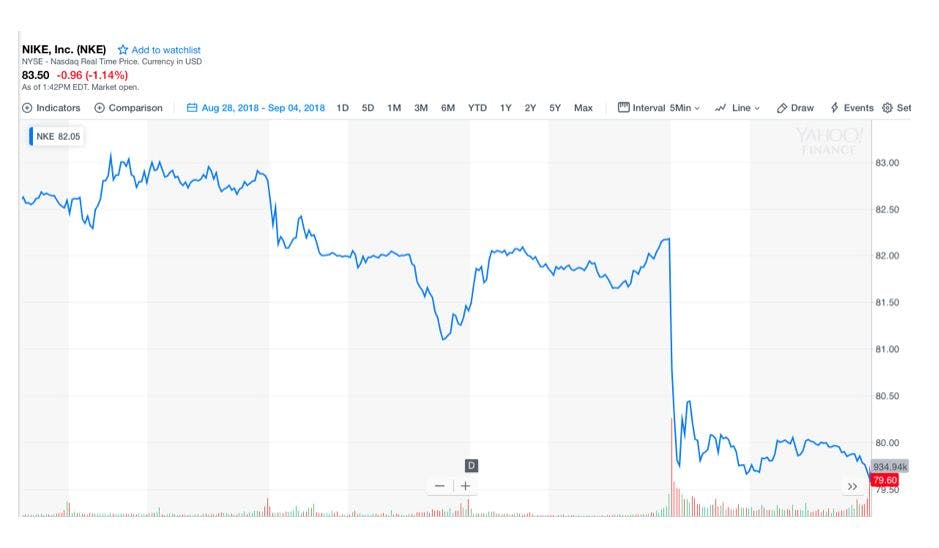
Of course, "the market" is made up of people who don't understand branding very well. The following weekend saw a 30+% increase in YOY online sales for Nike. The stock reached record highs over the ensuing month.
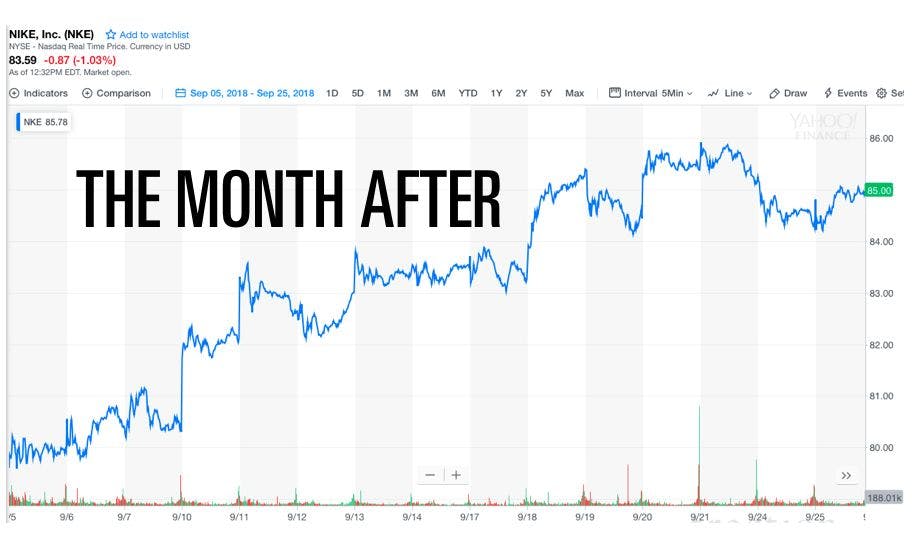
Here's a mind-blowing stat: 80% of brands linked to purpose beat the market.
"Let me jump on that bandwagon!" cries Joe CMO!
This is why we're seeing brands like Patagonia positioning themselves as environmental activists taking on the President of the United States by name. For some brands, taking a stand is good business.
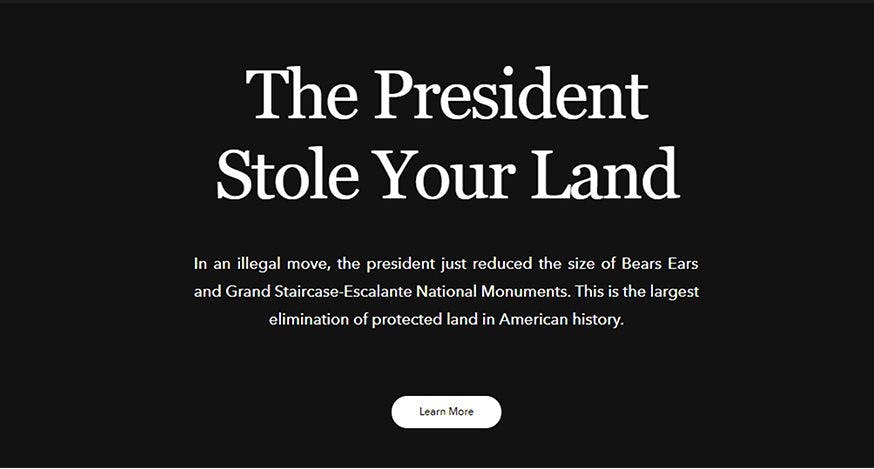
We're even seeing brand warfare over politically charged issues—REI, the leading outdoor retailer in the U.S., dumped CamelBak , the leader in hydration products (disclosure: CamelBak is a former client of my agency Traction ) following the Las Vegas mass shooting in March of this year because the company that owned them, Vista Outdoor, also owned a company that sold automatic weapons.
By May, Vista had sold off the gun brands and CamelBak is back on shelves.
But jumping into politics is high risk. First off, it requires authenticity. When Pepsi's infamous Kendall Jenner ad usurped the #BlackLivesMatter movement, the backlash from youth was fast and it was vicious. Pepsi pulled the ad shortly thereafter and had to issue an embarrassing apology. They hurt their brand.
And that's just the tip of the iceberg. When you start to cross the line from an oafish blunder like Pepsi did to actually taking a stand on an issue, the blowback can be far greater than many brands have the stomach for. As we learned firsthand at Traction last year...
The insane reaction to Days of Action
Last year, Traction introduced an HR policy called "Days of Action" giving people two days of paid leave per year to participate in democracy—however they see fit. We implemented it as a non-partisan policy designed to promote civic engagement, but people assumed our intentions were anti-Trump because we allow people to protest if they so choose.
The trolling we fell victim to was ferocious.
A post I wrote here on LinkedIn on "Why we're offering paid leave for activism" led to a worldwide whirlwind of controversy. We had tens of thousands of people calling us on the phone, emailing us, commenting on articles, posting on social media, trying to organize boycotts. Making threats of violence. We were called facists, socialists, communists, libtards, snowflakes, candyasses...
My team responded to the calls for boycott by selling "Boycott Traction" t-shirts and donating the money we made to the ACLU.
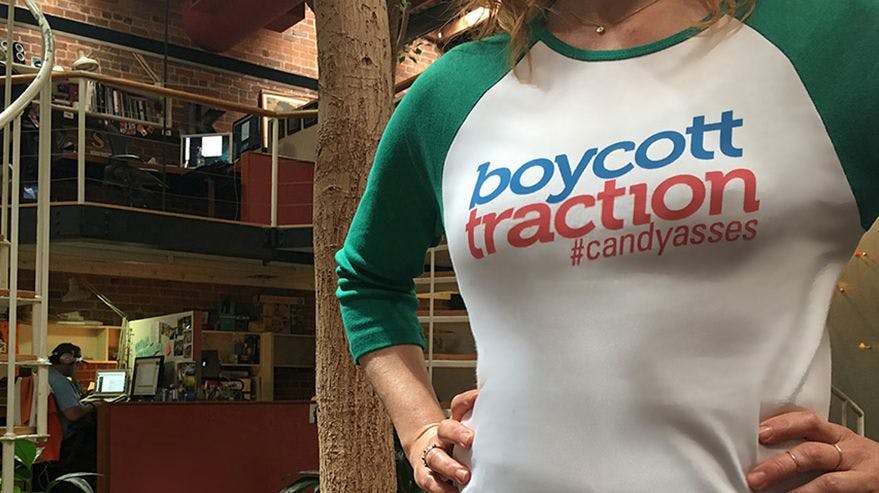
As an independent agency we had the luxury of choosing defiance as a response to the trolling. At the end of the day, the net impact to our business was positive: the credibility we gained as an agency that learned first-hand how to navigate brand politics far outweighed the prospects we lost from potential clients who agreed with our detractors. Despite the trolls, most people saw that the non-partisan nature of our effort transcended politics. Giant companies like United HealthCare, representing hundreds of thousands of employees, approached us to ask us about how we created the policy so they could create a similar one. We sparked a movement.
But, I'm not going to lie—it was scary there for a moment. It's one thing to get some controversial attention. It's quite another when your wife looks at you and asks, "Honey, are we safe?"
There aren't a lot of brand marketers out there that would be comfortable being the one that stimulated that kind of conversation between their CEO and her spouse.
The morale of the story? If you're Patagonia and all of your customers are outdoors enthusiasts, you're not exactly at risk to take a stand on environmental issues. Even if you're Nike and your most important target audience is young people in urban areas, the math works out when you support an athlete who took a stand on #BlackLivesMatter.
However, if you're a brand like Target and you do something like allow transgender people to use the bathroom they identify with because it's the decent thing to do, you could wind up facing a massive boycott that has an impact on your stock price.
Politics are powerful. But they're not for everyone.
Greenwashing: Not the answer
If politics is too hairy, is cause marketing the answer? At first glance, it might seem so. In a study conducted by Traction on cause marketing, 87% of people told us they'd prefer to buy from companies that are associated with causes they believe in. ( Email us if you'd like to see the full results of the study).
But, at the same time, 41% said they felt it was inauthentic, agreeing that cause marketing is "just spin," while another 40% said they felt everyone was doing it, and 26% actually think cause marketing is annoying.
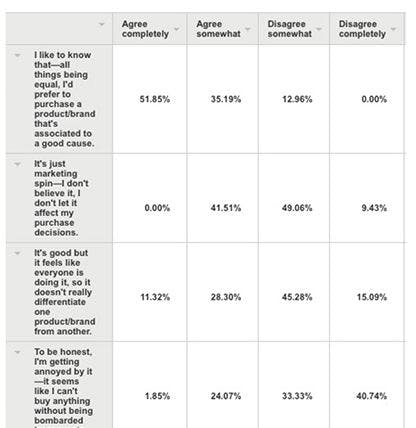
Our conclusion? The act of greenwashing—using causes to deceptively market your brand as friendly to an environmental or social cause—is fundamentally not good marketing. There are two reasons for this:
- It's not authentic. Your customer today is sophisticated. Their bullshit detector is on high alert. Brand purpose is something you earn through commitment and dedication. Try and fake it and people will see through your ploy—and hold you accountable for it.
- It's not differentiated. If everyone is doing it, the stance you take becomes invisible. Invisible marketing does not break through very well.
Breaking through with purpose + disruption
The word disruption sounds ugly. It sounds a lot like interruption. But that's not what I mean here.
A recent study by CEB illustrates the point empirically. They assessed 250 campaigns across 60 brands in 20 categories to see what kind of campaigns exceeded performance expectations. Product-focused , and entertainment or emotional-based campaigns didn't. Campaigns that affirmed a shared value had a marginally positive impact.
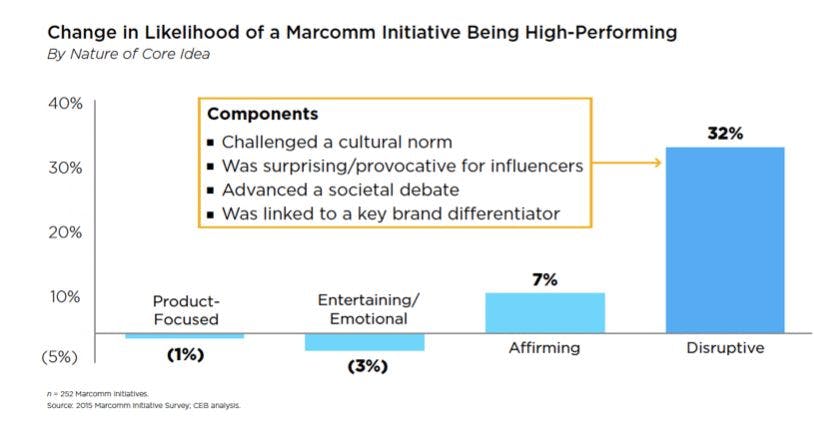
But campaigns that were described as disruptive were 32% more likely to outperform expectations.
Fundamentally, advertising works in one of two ways: it can create what we call "constructs" or ideas in peoples' minds, or it can reinforce constructs that already exist. Generally this takes repetition—especially to create one of these constructs. This is why marketers traditionally planned to buy enough GRPs so that their audience might see a given ad for a new product launch seven times. That's what it takes to penetrate their skulls.
But not all ads are created equal. Every day, thousands of ads are run in media that are simply invisible. People don't even notice them. They have no impact because they are ignored.
On the other hand, I'm sure every one of you out there reading this blog post can think of an ad that you may have only seen once, but that you'll remember for the rest of your life.
That is disruption.

The difference between affirming and disruptive in the above chart is that the former presents a construct by simply illustrating a shared value. The latter presents a brand purpose in the manner that creates cognitive dissonance—it takes a construct that already exists in someone's mind and turns it on its head in a way they never thought of before.
And when that happens, WHAM!!!! That's marketing with impact.
Take the Always "#LikeAGirl" campaign. The phrase "like a girl" is a construct that has existed with negative connotations in people's minds forever. Always presented that construct through the eyes of strong, confident, self-assured girls—and that twist that created cognitive dissonance made people fundamentally rethink that how that phrase was used in society.
That is purpose + disruption. And that is a formula for business growth.

Another great example is the Oreo rainbow cookie.
To celebrate its 100th anniversary, Oreo had their agency produce 100 social posts that showed cute art pieces made of Oreo's. As you can see from the image below, they were cute and they garnered some degree of engagement. But only one broke through.
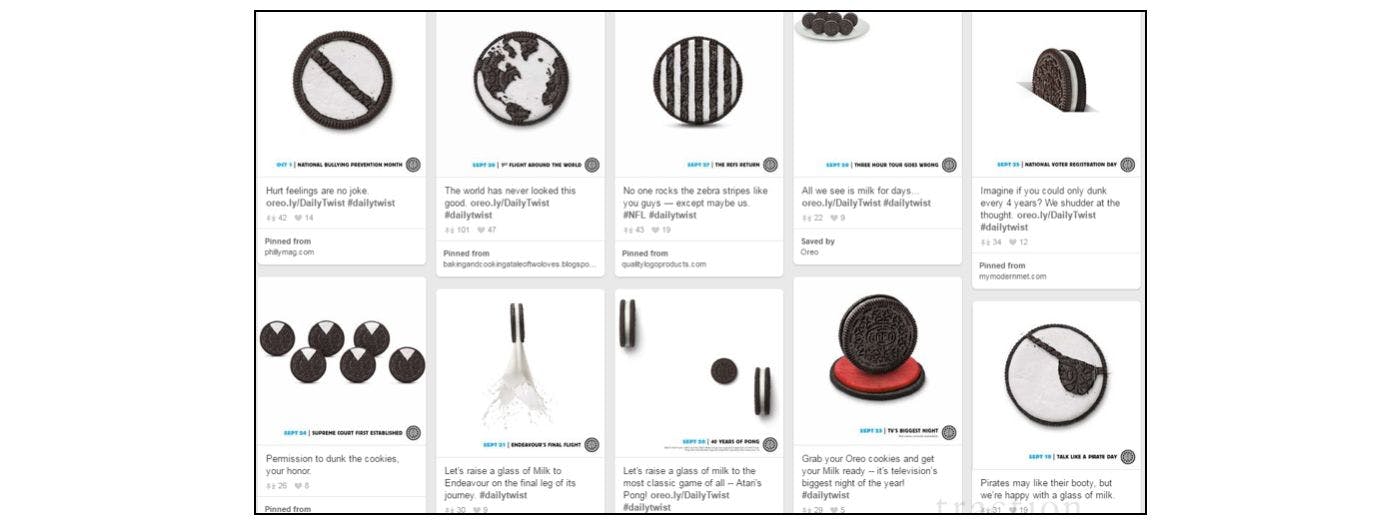
The rainbow cookie celebrating Gay Pride challenged a cultural norm. Yes, it affirmed a shared value held by a large and growing portion of the population, but did it in a disruptive way, presenting the construct of the Oreo cookie that existed in people's minds in an unexpected way that advanced a social debate—Pride is the mainstream.
That one post garnered 231,000,000 impressions on social media.
Insight is the foundation
In today's "always-on" marketing environment, efficiency and speed-to-market are frequently valued over sound marketing fundamentals. Great creative starts with great strategy. Great strategy starts with great insight.
The best definition I've heard of the word insight is "new understanding." New understanding comes from talking to your customers. When you take the time to listen to your customers and truly understand their needs, wants, desires and cultural influences, you can unearth the potential to truly break through.
At +CTG, I had a chance to talk with Paco Conde, the creative director who worked on Dove's Real Beauty sketches campaign—possibly the most viewed campaign in advertising history. He told me the brief from the client was one line:
"Only 4% of the world's women describe themselves as beautiful—how can we empower the other 96%?"
Breaking through is critical today. Consumers are harder to reach than ever before. Meanwhile, CMOs are tasked with driving business growth. Purpose, disruption and politics are strategies your brands can use to achieve this.
Look to your customers to understand which ones are right for you.

An armchair analysis of the strategies being put forth by WPP's New CEO Mark Read and ex-CEO Martin Sorrell.

A post from the Marketoonist quoted an article I had written months earlier in Ad Age on "Why Data-Driven Creative equals Mediocre Creative."

As more ad dollars get spent digitally each year, advertisers find themselves obsessing over the data in their campaign reports and centralizing how they access data.
